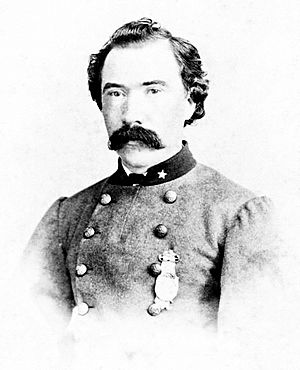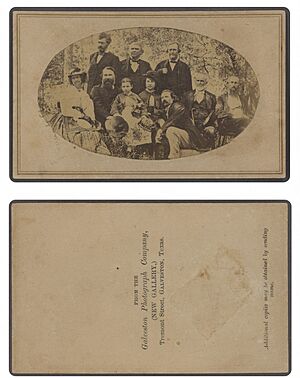Richard W. Dowling facts for kids
Quick facts for kids
Richard William Dowling
|
|
|---|---|

Dowling in uniform, ca. 1865
|
|
| Nickname(s) | "Dick" |
| Born | January 1837 Milltown, Ireland, U.K. |
| Died | 23 September 1867 (aged 30) Houston, Fifth Military District, U.S. |
| Buried |
St. Vincent's Cemetery
Houston, Texas, U.S. |
| Allegiance | |
| Service/ |
|
| Years of service | 1861–1865 |
| Rank | |
| Commands held | Company F (Davis Guards), 1st (Cook's) Texas Heavy Artillery Regiment |
| Battles/wars | American Civil War
|
| Awards |
|
Richard William "Dick" Dowling (born January 14, 1837 – September 23, 1867) was an Irish-born artillery officer who became famous during the American Civil War. He led his troops to a major victory at the Second Battle of Sabine Pass in 1863. This battle was one of the most one-sided wins for the Confederates. It stopped the Union army from taking over Texas.
For his brave actions, Dowling received special honors. These included the "thanks of Congress" (from the Confederate States), the Davis Guards Medal, the Southern Cross of Honor, and the Confederate Medal of Honor. Many memorials have also been made to remember him.
Contents
- Richard Dowling's Early Life
- Dowling's Business Ventures
- Richard Dowling and the Civil War
- After the War and Dowling's Death
- Remembering Richard Dowling
- Davis Guards Medal (1863)
- Thanks of Congress (1864)
- Dowling Street (1892)
- Tuam Street (1892)
- Southern Cross of Honor (1899)
- Statue (1905)
- Obelisk (1935)
- Sabine Pass Battleground State Historic Site (1936)
- Monument (1937)
- Dick Dowling Elementary School (1953)
- Confederate Medal of Honor (1977)
- Dowling Middle School (1968)
- Tuam Plaque (1998)
- Images for kids
Richard Dowling's Early Life
Dowling was born in January 1837 in a small village called Knockballyvishteal, near Milltown, County Galway, Ireland. He was the second of eight children. His family were farmers.
In 1845, when he was nine, his family lost their home. This was at the start of the Great Famine. In 1846, young Dowling and his older sister, Honora, left Ireland for New Orleans in the United States.
Moving to New Orleans and Houston
As a teenager, Dick Dowling showed he was good at business. He successfully ran a saloon called the Continental Coffeehouse in the busy French Quarter of New Orleans. His parents and other siblings came from Ireland in 1851. But sadly, in 1853, a yellow fever outbreak in New Orleans caused the deaths of his parents and one younger brother.
In 1857, Dowling moved to Houston, Texas. He leased his first saloon there, a two-story building called "The Shades." It was known for its shady trees. He also opened a billiards saloon on the first floor. People described Dowling as a friendly, red-headed Irishman with a big mustache. Friends and family called him "The Kid." In 1857, he married Elizabeth Ann Odlum. Her father had fought in the Texas Revolution.
Dowling's Business Ventures
By 1860, Dowling owned several saloons. His most successful one was called the Bank of Bacchus in downtown Houston. Locals called it "The Bank." It became a very popular place for people to gather in the 1860s. Dowling was good at getting attention from local newspapers. He also bought many properties.
He helped start Houston's first gaslight company. He was the first to have gaslights in his home and "The Bank." Dowling also helped create Houston's first fire department. He was involved in running the city's first streetcar company too.
Richard Dowling and the Civil War
Joining the Confederate Army
Before the Civil War began, Dowling was already a well-known businessman. He was part of an Irish militia group in Houston. This group was more for social events than military training. When Texas decided to leave the Union, this militia joined the Confederate States Army. Dowling was chosen as a First Lieutenant.
His unit was mostly made up of Irish men from Houston, many of whom were customers from his saloons. They called themselves the "Davis Guards." They honored Confederate President Jefferson Davis. The Davis Guards first helped take over Union Army forts along the border with Mexico. They did this without any fighting. They also fought in the Battle of Galveston on New Year's Day in 1863. After that, they were sent to a new artillery post near the mouth of the Sabine River. This post was first called "Fort Sabine," then "Fort Griffin."
Preparing for Battle at Sabine Pass
Sabine Pass was a key spot for ships that tried to get around the Union blockade. By July 1863, the Civil War was not going well for the Confederacy. It seemed like the Union Army might try to invade Texas. People thought they would come through Sabine Pass. This was because it was a good harbor and close to Beaumont, which had a railroad.
To get through Sabine Pass, large ships had to use one of two narrow channels. These channels were only about 5 feet deep. They were separated by "oyster-banks" that were only 2 feet under the water. Any large ship had to follow these channels carefully. Both channels were within easy reach of the fort's six cannons.
Dowling spent the summer of 1863 training his men at the fort. He taught them how to aim their cannons. He put long, white poles in the channels at different spots. These poles helped his gunners know the best distance and angle for each shot.
The Battle of Sabine Pass (1863)
On September 8, 1863, a Union Navy fleet arrived near Sabine Pass. It had about 22 gunboats and transport ships with 5,000 soldiers, plus cavalry and artillery. The Union plan was to send four gunboats up the pass quickly to draw fire from the fort. This tactic had worked before in other battles.
But this time, Dowling's training paid off. The Confederates fired quickly and accurately at the incoming gunboats. They hit several ships directly, disabling and capturing two of them. The other Union ships quickly turned back. The rest of the Union fleet retreated, leaving their damaged ships to surrender to Dowling.
With only 47 men, Lieutenant Dowling had stopped a huge invasion of Texas. He captured two gunboats, about 350 prisoners, and many supplies. This was a huge victory for the Confederates.
The Davis Guards Medal
The Confederate States Congress praised Dowling and his men for their bravery. Dowling was promoted to Major. As a thank you, the "ladies of Houston" gave special medals to the unit. These medals were made from Mexican coins. They had "Sabine Pass, 1863" on one side and a Maltese Cross with the letters D and G on the other.
After the War and Dowling's Death
After the Battle of Sabine Pass, Dowling became a hero in Houston. He helped recruit soldiers for the Confederacy. Jefferson Davis himself praised Dowling for his actions.
After the war, Dowling went back to his saloon business in Houston. He quickly became one of the city's top businessmen. But his promising future ended too soon. Another yellow fever outbreak hit Houston in the summer of 1867. Richard Dowling died on September 23, 1867, at the age of 30.
He was buried at St. Vincent's Catholic Cemetery in Houston. This is the oldest Catholic cemetery in the city.
Remembering Richard Dowling
Many places in Houston were named after Dowling. However, over time, fewer people in the city remembered him. Some places named after him have since been renamed. For example, Dowling Street is now Emancipation Avenue. Dowling Middle School is now Lawson Middle School.
Davis Guards Medal (1863)
The Davis Guards Medal was given by the "ladies of Houston" in 1863. It was given to Dowling's artillery company. It is thought to be the only medal allowed to be worn on the Confederate uniform. Only 3 of the 50 medals made are still known to exist today. You can see them in museums like the American Civil War Museum.
Thanks of Congress (1864)
On February 8, 1864, Dowling and his men received the "thanks of Congress." This was a special honor from the Confederate government.
Dowling Street (1892)
In 1892, the Houston City Council renamed East Broadway to Dowling Street. In 2017, the city council changed its name again to Emancipation Avenue.
Tuam Street (1892)
In 1892, the Houston City Council also named a street Tuam Street. This street is next to Dowling Street. It was named after Dowling's birthplace, Tuam, Ireland.
Southern Cross of Honor (1899)
Dowling was given the Southern Cross of Honor in 1899, after his death. This was another award for his service.
Statue (1905)
In 1905, the Houston City Council ordered a statue of Dowling. It was made by Frank Teich. The statue was first at Houston City Hall. Later, it was moved to Sam Houston Park and then to Hermann Park. In 2020, the City of Houston moved the statue into storage. This was the first public monument ordered by the city government.
Historical Marker (1998)
The site where the statue was placed received a Historical Marker in 1998.
Obelisk (1935)
In October 1935, a granite monument called an obelisk was built near Dowling's grave. It is at Saint Vincent's Cemetery in Houston. A plaque on it says: "Near this spot lies LT DICK DOWLING Hero of the Battle of Sabine Pass".
Sabine Pass Battleground State Historic Site (1936)
The Sabine Pass Battleground State Historic Site is where the famous battle took place. It is a heritage site run by the Texas Historical Commission. It has a statue of Dowling and a memorial for the Davis Guards.
Dowling Road (1936)
Dowling Road leads to the Sabine Pass Battleground State Historic Site.
Historical Marker (1936)
The Sabine Pass Battleground State Historic Site also received a Historical Marker in 1936.
Monument (1937)
In 1937, the United Daughters of the Confederacy put up a granite monument for Dowling. It was in downtown Sabine Pass, Texas. It was moved to a new spot in the 1960s.
Dick Dowling Elementary School (1953)
In March 1953, the Dick Dowling Elementary School was built in Port Arthur, Texas. It was renamed Port Acres Elementary School in 2018.
Confederate Medal of Honor (1977)
Dowling was given the Confederate Medal of Honor in 1977, after his death.
Dowling Middle School (1968)
In 1968, the Richard W. "Dick" Dowling Middle School was built in Houston, Texas. It was renamed Audrey H. Lawson Middle School in 2016.
Tuam Plaque (1998)
In 1998, the town of Tuam, Ireland, put a bronze plaque of Dowling on its Town Hall. It shows his picture and tells about his achievements. This was the first known memorial to an Irish-born Confederate soldier in Ireland. The plaque says:
- Major Richard W. (Dick) Dowling C.S.A., 1837-1867 Born Knock, Tuam; Settled Houston Texas, 1857; Outstanding business and civic leader; Joined Irish Davis Guards in American Civil War; With 47 men foiled Invasion of Texas by 5000 federal troops at Sabine Pass, 8 Sept 1863, a feat of superb gunnery; formed first oil company in Texas; Died aged 30 of yellow fever. This plaque was unveiled by Col. J.B. Collerain 31 May 1998
In 2017, a local council member suggested removing the plaque. But no one supported the idea. Another council member said the plaque was about Dowling's business life.
Images for kids
-
Davis Guards Medal, 1864
-
Dowling's Grave, St. Vincent's Cemetery, 1867
-
Obelisk, St. Vincent's Cemetery, 1935
-
UDC Memorial, Sabine Pass, 1937
-
Plaque, Tuam, 1998









